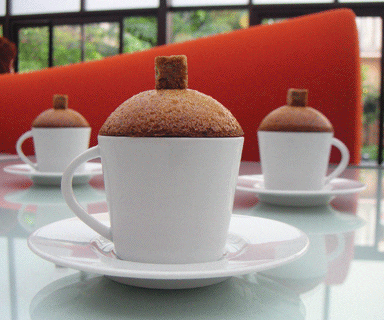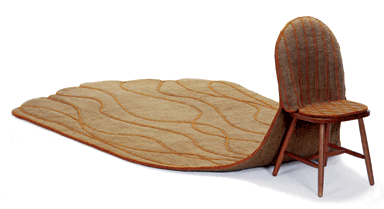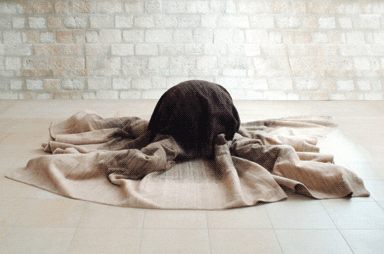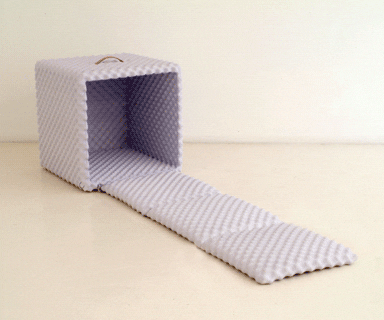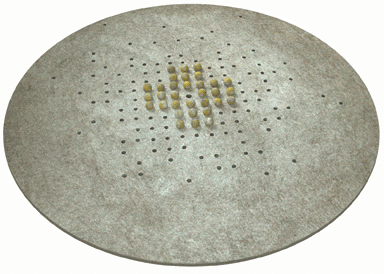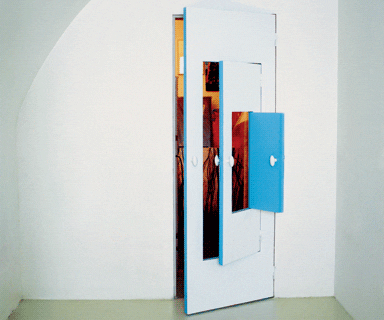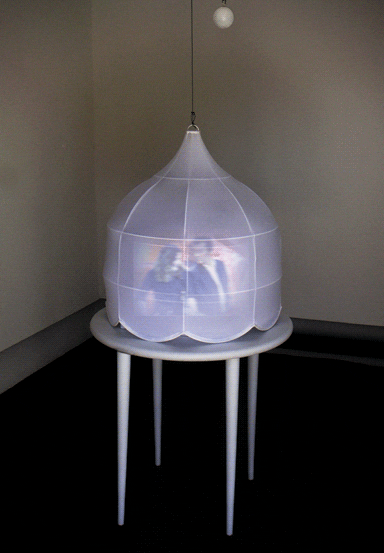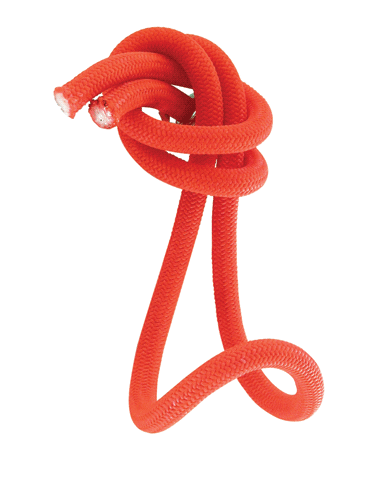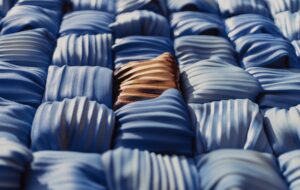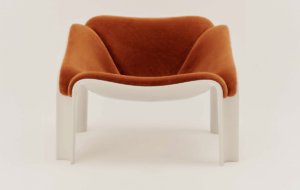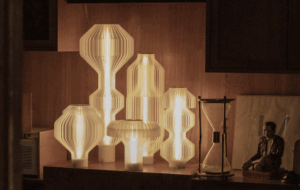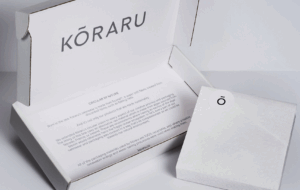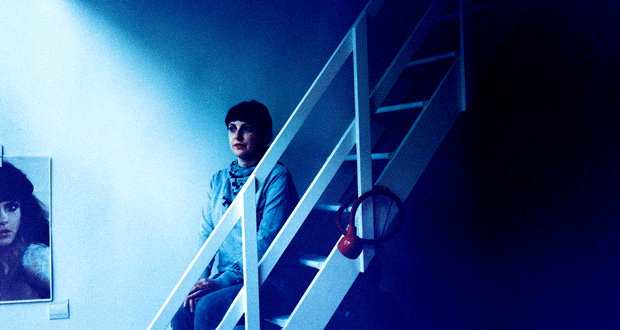
words Anna Bates
portraits Mel Bles
Florence Doléac is waving a hand in the air. “I feel completely amused by situations I see. Everything is strange to me, but I feel fine in this reality. It’s enough fictional, enough absurd, enough crazy.”
Classical music is playing in the background of Doléac’s quiet live-work studio in Paris, and the 39-year-old designer is sitting cosily with a cup of tea in her hand. Everything looks, on the face of it, quite normal, but Doléac is explaining the thought processes that inspired such pieces as Patate, a giant ceramic spud that stores the ashes of deceased family members in protruding sprouts, and Télélumine, a lampshade that hangs over a muted television, turning it into a light.
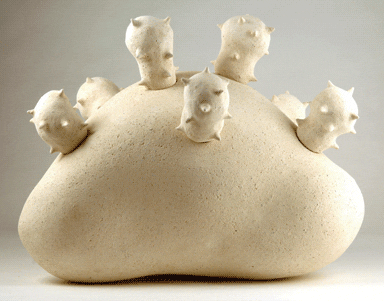
“My definition of design is that we are doing prosthesis,” says Doléac, picking up a chair. “This is a prosthesis.” The chair lands with a clunk. “I can’t put my finger in the tea – waaah!” she demonstrates. “But I have a spoon. Prostheses to me can be fantasist, or they can be stupid or undramatic.”
Rather than try to change the way we live, Doléac attempts to make us rethink routines, actions and scenarios. Hers is a very tactile practice – she designs less for the visual than for the other senses, and is obsessed with how we engage with objects. For example, her Soft handle of 2002, a door handle covered with a large balloon filled with flour, shapes to fit the user’s own hand rather than vice versa.
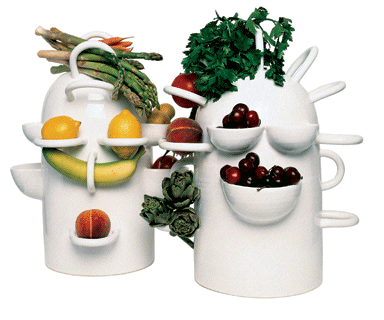
Doléac’s work is playfully conceptual – chairs that turn into carpets, carpets that turn into games, fruit bowls that look like children’s toys. Her themes are connectivity and transformation – design as a kind of performance. Yet her approach was frowned upon at Paris’ prestigious ENSCI, where she studied industrial design. “My teachers were convinced I was made for theatre,” she says. “Every six months, they would try to throw me away – ‘This student, she’s bad, she’s not made for reality.’ I had to fight for five years to stay there.”
It wasn’t the only time Doléac was asked to leave. Four years ago she was dismissed from RADI, the design collective she co-founded at college, because she couldn’t stick to the group timetable. “They said change or go. I thought sod that,” she says. She left the group and with it her husband, a fellow member. “I jumped – wooof! And suddenly it was empty and quiet. God, I thought, what did I do to get here?”
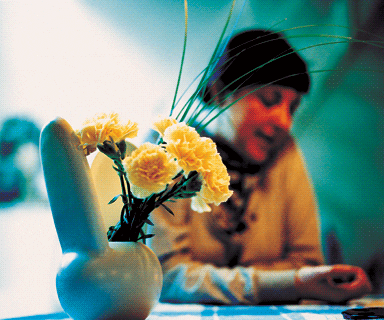
Doléac was born in 1968, the year of the student uprisings in Paris. She describes herself as a “child of the revolution”, but she grew up in the French countryside and was raised by parents who “weren’t in revolution mode”. At odds with the attitudes of the people around her, Doléac headed in 1986 to Toulouse, the nearest city, to study graphics. She made the big move to Paris in 1989 to study industrial design, and she now teaches at design schools ECAL in Switzerland and ENSAD in Paris.
Doléac isn’t your obvious misfit. Sociable and charismatic, she shoots from the hip and likes to demonstrate her points with entertaining hand movements and sound effects. But re-entering the design world after being rejected has shaped her conceptual approach. With no money or staff, Doléac had to forge a career out of her ideas, which contributed to pushing her into the margins of design – most of her work can only be found in galleries.
Working independently has, however, helped give her a critical distance on human behaviour. “We are acting like robots,” says Doléac, slicing the air with her hands. “Choc, choc. We just separate everything – the day, the night, the evening, the morning. Everything is organised. Somehow we became so boring. We forgot how to think.”
She points to the handle of her patio door – it’s covered with a sponge soaked in blue paint above a paint puddle on the floor – a piece made for a recent exhibition in Paris. “You have to use a door handle about a hundred times a day,” she says. “It’s part of our daily life – ding ding – this movement. It’s not cosy to change rooms. The light and the temperature change – I like to consider it’s like a little trauma,” she grins. “I play with this. I like to make an interlude, a little joke.”
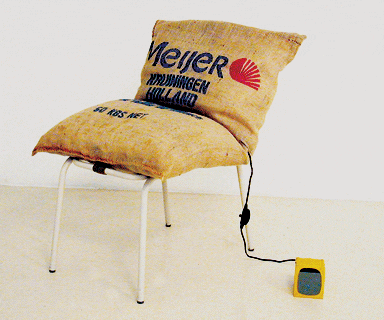
This kind of whimsical intervention is characteristic of Doléac’s work. Her interest is in moments, and through an object she can make you step back and observe yourself – as if you’re freeze-framing routine actions in your daily grind. In 2004 she designed a crude “relaxation” chair with vibrating cushions – it’s not relaxing at all, it’s made to make you aware of sitting. Her work is confrontational and thrives in making us feel uncomfortable – stupid even – and she is unafraid to stoop to the lowest common denominator. Her Signpost handle for toilet doors, with a shape resembling a shit but made of reinforced resin and silver leaf, reflects the kind of comic awkward tension surrounding such subject matter.
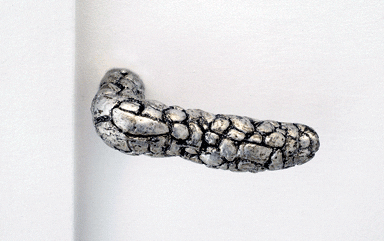
But Doléac’s social commentary digs a little deeper than just the mundane. “We are super intelligent, and super fragile,” she says. “We are the only animal that knows we are going to die. If we imagine it, it is unbearable, so we spend life pretending it is not like that. But I think it makes us crazy.”
Doléac’s work attempts to address some of our greatest fears and anxieties. By using humour and a sense of the ridiculous, she subverts dramatic or difficult situations and makes us reassess them. Tu ronfles moi non plus (You snore, me neither) is a soundproofed “survival box” designed for a couple to use after an argument. Whoever is most annoyed – the woken snorer or the one kept awake – sleeps in it, so the argument is a critical part of the object’s function. With Patate, Doléac punctures the social taboos surrounding death by suggesting our ashes should end up in a potato sprout. “Don’t fake the dramatic with flowers and granite,” she says. “Death is natural – so here is a potato – just go into the potato.”
It sits uncomfortably in our deeply sentimental society, and has an affinity with the “critical design” of London-based practice Dunne and Raby. It’s not just about making new objects, it’s about questioning our relationship with objects in specific situations. But while the British duo highlights the fragility of the human environment with no attempt to problem-solve or rectify, Doléac’s work veers towards the utopian. “If you are depressed and you don’t like your life, you can’t help others,” she says. “I think a frustrated designer can be a disaster.” Her approach comes from desiring a more coherent life, where arguments and dying are perceived less as dramatic and more as inevitable.
But Doléac is a designer who prefers to suggest rather than dictate. “I’m not like Van Lieshout, trying to make my own world with my own society and whatever,” she says. “To me life is complicated enough not to be manipulated by designers who say, ‘Act like this’.” Télélumine is an obvious criticism of our television-obsessed society, but pull the cord and the screen is revealed once more. “I don’t cancel things,” she says.
The problem is that Doléac’s “suggestions” don’t end up in people’s houses, where they could potentially make powerful and entertaining contrasts. In fact, Doléac isn’t even happy with them being displayed in a gallery context – finding the pressure to sell her pieces (which rarely happens) awkward. She’d prefer it if her work couldn’t be purchased at all. “My pieces are more for a museum, maybe.”
However, there are certain pieces that could become viable products but never make it onto the market. She has ambitions to produce some of her more sellable concepts – the Soft handle, and a ceramic floor-tile with massage protrusions – but she seems to be held back by a lack of confidence and indecision. “I don’t know where to do it,” she says. “I have many sleepy projects because I don’t know who to do them with.”
Partly because of her softly softly approach, no one quite knows what to make of Doléac. Her work is often self-indulgent, provoking puzzled reactions from gallery visitors, and it isn’t yet accepted in the art world. Perhaps she is just in the wrong city. There is no funding in France to help creatives work abroad – so she hasn’t tried. For one reason or another, Doléac’s work is underexposed, and seems wasted sat so long in the margins. “I feel a bit strange here,” Doléac says. It may well be time for her to move.
